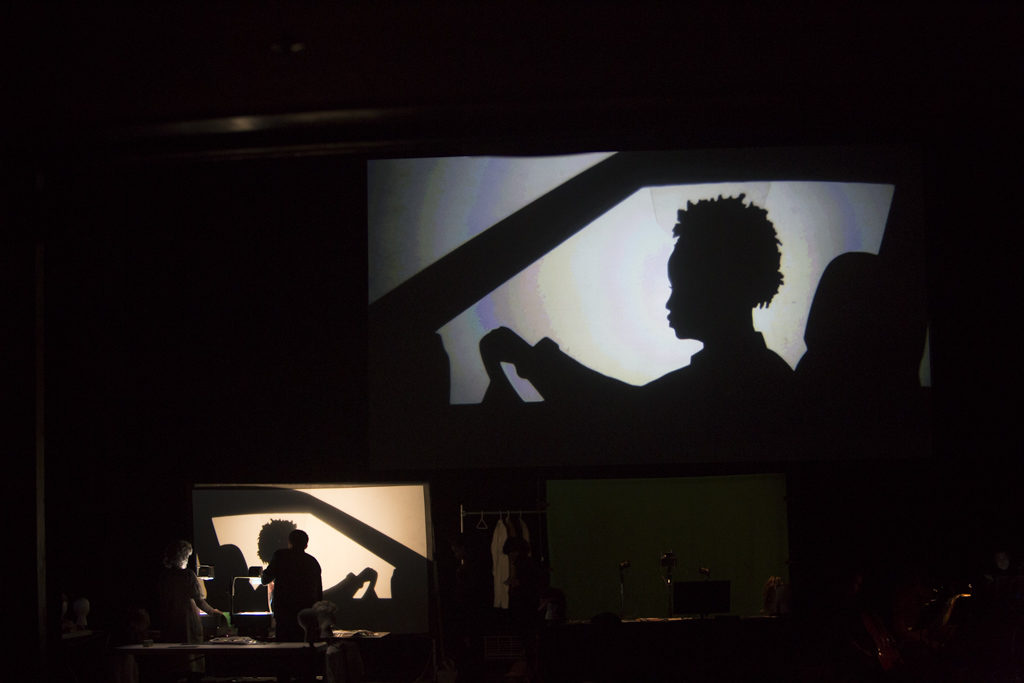The End of TV: Manual Cinema Presents Another Unusual And Stunning Work

Manual Cinema has returned to Boston’s ArtsEmerson with their latest work The End of TV just a year after their delightful showing of Ada/Ava. The company was set up in 2010 as a collaborative of three men and two women dedicated to modernizing shadow puppetry through combining theatre and film. Nonetheless, as with Ada/Ava, there are no words spoken by the characters. The only dialogue presented is taken from old television commercials that are dubbed by the puppeteers. Kyle Vegter and Ben Kauffman are responsible for the script.
Sound has a more important role in The End of TV than it did in Ada/Ava. There is an orchestra of five musicians consisting of a cellist, violinist, guitarist/keyboardist, flautist, and sound effects performer. Both the music they play and the lyrics they sing are original, composed and written by the show’s authors. There are eight songs in all, several dealing with the bad economy of the early 1990s, but all a pleasure to hear.
Like Ada/Ava, The End of TV features two female characters that have a close relationship. One is Flo (Kara Davidson) a retired elderly white woman who earlier was a manager at an automobile factory and now spends her days watching television ads while continually ordering items. Dementia has taken over her life. The other is Louise (Sharaina L.Turnage) a young black woman who was coping well until the car plant where she worked closed. Since the only job she can find is as a driver for Meals on Wheels, she is unable to pay her mortgage and consequently loses her house.
Louise becomes friendly with Flo when she delivers her meals and is gratified by Flo’s response which improves with each visit. Neither woman appears to know the work history of the other. When alone, Flo seems to have strokes, but it is unclear if these are repetitive or if she is lost in time. Both women live in a town not far from a large Midwestern city whose skyscrapers are visible across a river. One day Louise finds a for sale sign on Flo’s house and both character and audience realize she is dead.
Louise continues to make the best of her life driving daily to drop off meals and takes up gardening as a new hobby.
The company regenerates the film at each showing when it is replayed and projected on a large screen high above the stage. As in Ada/Ava, the actors perform in profile to create the impression of shadow puppets on a small screen upstage. There is a striking difference between what the actor is doing in front of the small screen and the performance seen on the large screen.
Contrasting with the black and white films of the silent film epoch are color television ads from QVC shopping network which make use of a smaller projector stage right and are projected onto a second large screen. Four actors lip-sync the original TV dialogue. Color is also used occasionally in high moments of the production.
The End of TV is a complex play that deals with important issues: aging, unfairness, loss, poverty, death. Both Flo and Louise have lost family members. In Louise’s case, she had been at odds with her father which she regretted when found him dead in his garden. Flo’s young daughter died in an automobile accident years earlier, an ironic touch. At the same time, The End of TV is notable for its comic aspects.
The End of TV continues at Arts Emerson’s Paramount Theatre on Washington Street in Boston through January 27.
Direction, Storyboards and Masks …Julia Vanarsdale Miller
Puppet Designer ……………………Lizi Breit
Costumes ………………………….. Mieka Van Der Ploeg
Lighting Design ……………………Claire Chrzan
Female Ensemble, Puppeteer ………Vanessa S. Valliere
Male Ensemble, Puppeteer …………Jeffrey Paschal